Infographics

Surprising Migration Movements Discovered
This interactive presentation highlights our recent grassland bird migration research for you to explore. Experience the sights and sounds of Grasshopper Sparrow and Upland Sandpiper research from the field, and delve into full-color maps displaying location data we received from our geolocator-toting birds.
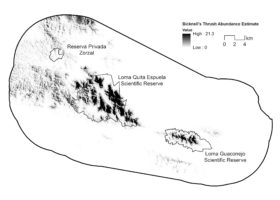
Expected abundance of Bicknell's Thrush in the eastern Cordillera Septentrional, Dominican Republic
We conducted standardized field surveys for the Bicknell’s Thrush in forests of the Dominican Republic’s Cordillera Septentrional, an area of high importance for females. We combined occurrence data with environmental variables to create a model of thrush distribution and habitat selection in the region. We used this information to identify, purchase, and create the Dominican Republic’s first-ever private reserve, the 400-ha Reserva Privada Zorzal. Our model can be used to identify and prioritize additional lands for conservation of the Bicknell’s Thrush in the region.
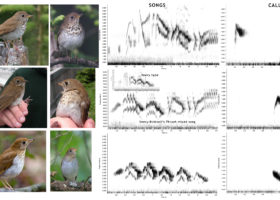
Documentation of a hybrid Bicknell's Thrush (Catharus bicknelli) × Veery (C. fuscescens) using vocalization and genetic data
We discovered an unexpected avian phenomenon: the first known case of a Bicknell’s Thrush x Veery hybrid. These findings were published this month in the The Wilson Journal of Ornithology by lead author Ellen Martinsen and VCE coauthors Kent McFarland and Chris Rimmer.
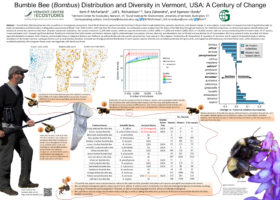
Bumble Bee Distribution in Vermont: A Century of Change
About half of Vermont’s bumble bee species, which are vital crop pollinators, have either vanished or are in serious decline. From 2012-2014, with help from 53 citizen scientists, we conducted surveys to determine the status of bumble bees throughout Vermont. For historical comparison, we determined species identifications and databased bumble bee specimen data from 24 public and private collections.
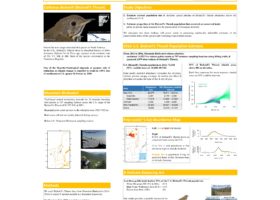
Tools for High Elevation Landowners and Managers
VCE developed an online mapping tool that predicts the abundance of Bicknell's Thrush across the Northeastern US landscape. Learn more about this tool from a poster that VCE presented at the 2018 Waterman Fund's Northeastern Alpine Stewardship Gathering.
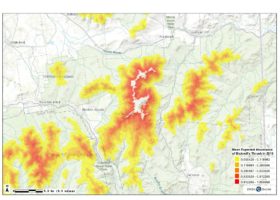
Bicknell’s Thrush Abundance Map
New research by VCE has revealed that Bicknell’s Thrush likely have one of the smallest population sizes – about 71,000 adult birds – of any migratory songbird within the contiguous U.S. The data used in the study were garnered over the last six years by trained citizen scientists, who are experienced birders, under the Mountain Birdwatch (MBW) monitoring program.
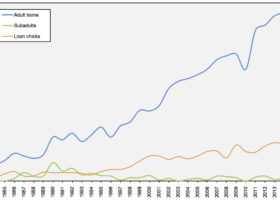
Annual Loonwatch Results
One the third Saturday in July of every year, LoonWatch volunteers take to the water to count loons. It’s the single most effective way for VCE to document and track breeding loons across the state.
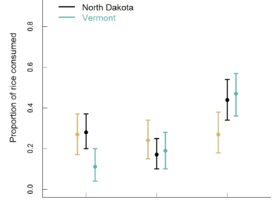
Winter Diet of Bobolink Inferred from Feather Isotopes
We found that while rice is an important component of the Bobolinks winter diet, they still rely even more heavily on other plants, presumably natural grasses. But rice is important during a critical time when Bobolinks are completing their winter molt and also preparing for their rapid northward migration.
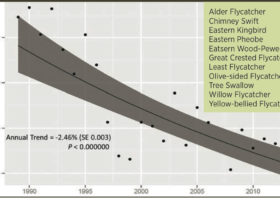
Aerial Insectivores Declining
A 25-year study of Vermont’s forest birds, including woodpeckers, warblers and other iconic species, has documented a 14.2 percent overall population decline during the period, raising concerns about birds and forests alike. As a group, aerial insectivores (the 11 species listed in the box) have declined by 45% on FBMP surveys, corroborating an alarming trend in North America.
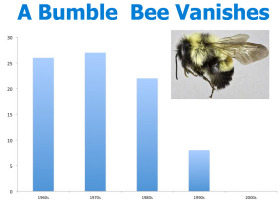
Bumble Bee Decline
Historically, Rusty-patched Bumblebees ranged from Minnesota east to Maine and
as far south as Georgia. Recent surveys, however, show an extreme contraction of the species’ range with only isolated patches remaining in Midwestern and Northeastern states. Bombus affinis was last observed in Vermont in 1999.
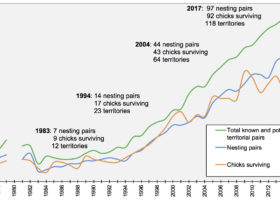
Common Loons: A Conservation Success Story
Although we evaluate the conservation of Common Loons in many ways, the best measure of our success is this: the number of nesting loons in Vermont has risen dramatically from a mere seven when our recovery efforts began 40 years ago.
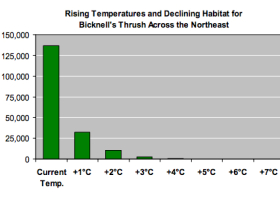
Predicted Habitat Loss From Climate Change
The disappearance of the Bicknell’s Thrush montane fir forest habitat is fairly simple to envision. The fir zone essentially amounts to a cap, or a habitat island, on suitable mountaintops. Under the rising mean summer temperatures examined by the VCE biologists, the fir zone literally loses ground. Warming climate causes the lower boundary of this zone to gradually retreat up the mountain.
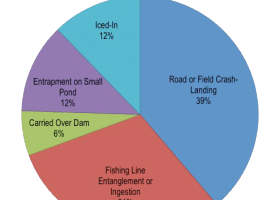
Loon Rescues: Where and How
From 2000-2014, the Vermont Loon Conservation Project, its volunteers, and state game wardens have saved 49 Common Loons. Most of these were adults.













